Melatonin Rinsing Treatment Associated with Storage in a Controlled Atmosphere Improves the Antioxidant Capacity and Overall Quality of Lemons
Abstract
1. Introduction
2. Materials and Methods
2.1. Materials and Treatments
2.2. Color Measurement and Browning Index
2.3. Fruit Quality
2.4. Enzyme Activity
2.5. Antioxidant Capacity
2.6. Scanning Electron Microscopy (SEM)
2.7. Aroma Analysis by E-Nose
2.8. Statistical Analysis
3. Results and Discussion
3.1. Effect on Color and Chlorophyll Content of Lemon Fruit
3.2. Effect on Quality Characteristics of Lemon
3.3. Synergistic Promotion of TPC and Inhibition of ROS
3.4. Enhancing the Activity of POD, PPO, and PAL and Inhibiting Membrane Peroxidation
3.5. Regulation of Volatile Substances by MT and CA
3.6. Lemon Microstructure
3.7. Correlation Analysis
4. Conclusions
Author Contributions
Funding
Institutional Review Board Statement
Informed Consent Statement
Data Availability Statement
Conflicts of Interest
References
- Serna-Escolano, V.; Valverde, J.M.; García-Pastor, M.E.; Valero, D.; Castillo, S.; Guillén, F.; Martínez-Romero, D.; Zapata, P.J.; Serrano, M. Pre-Harvest Methyl Jasmonate Treatments Increase Antioxidant Systems in Lemon Fruit without Affecting Yield or Other Fruit Quality Parameters. J. Sci. Food Agric. 2019, 99, 5035–5043. [Google Scholar] [CrossRef]
- Huang, R.; Xia, R.; Hu, L.; Lu, Y.; Wang, M. Antioxidant Activity and Oxygen-Scavenging System in Orange Pulp During Fruit Ripening and Maturation. Sci. Hortic. 2007, 113, 166–172. [Google Scholar] [CrossRef]
- Sun, Y.; Singh, Z.; Tokala, V.Y.; Heather, B. Harvest Maturity Stage and Cold Storage Period Influence Lemon Fruit Quality. Sci. Hortic. 2019, 249, 322–328. [Google Scholar] [CrossRef]
- Badiche-El Hilali, F.; Valverde, J.M.; García-Pastor, M.E.; Serrano, M.; Castillo, S.; Valero, D. Melatonin Postharvest Treatment in Leafy ‘Fino’ Lemon Maintains Quality and Bioactive Compounds. Foods 2023, 12, 2979. [Google Scholar] [CrossRef]
- Kaur, J.; Jawandha, S.K.; Gill, P.P.S.; Grewal, S.K.; Singh, H.; Adhikary, T. Beeswax Enriched Gibberellic Acid Coatings Preserve Antioxidant Properties and Quality of Lemon Fruit under Cold Storage Condition. Acta Physiol. Plant. 2023, 45, 93. [Google Scholar] [CrossRef]
- Liao, L.; Li, S.; Li, Y.; Huang, Z.; Li, J.; Xiong, B.; Zhang, M.; Sun, G.; Wang, Z. Pre- or Post-Harvest Treatment with Meja Improves Post-Harvest Storage of Lemon Fruit by Stimulating the Antioxidant System and Alleviating Chilling Injury. Plants 2022, 11, 2840. [Google Scholar] [CrossRef]
- Chen, F.; Zhang, J.; Chen, C.; Kowaleguet, M.G.G.M.; Ban, Z.; Fei, L.; Xu, C. Chitosan-Based Layer-by-Layer Assembly: Towards Application on Quality Maintenance of Lemon Fruits. Adv. Polym. Technol. 2020, 2020, 7320137. [Google Scholar] [CrossRef]
- Frempong, K.E.B.; Chen, Y.; Liang, L.; Lin, X. Effect of Calcium Chloride and 1-Methylcyclopropene Combined Treatment on Pectin Degradation and Textural Changes of Eureka Lemon During Postharvest Storage. Curr. Res. Food Sci. 2022, 5, 1412–1421. [Google Scholar] [CrossRef]
- Ma, Y.; Li, S.; Yin, X.; Xing, Y.; Lin, H.; Xu, Q.; Bi, X.; Chen, C. Effects of Controlled Atmosphere on the Storage Quality and Aroma Compounds of Lemon Fruits Using the Designed Automatic Control Apparatus. BioMed Res. Int. 2019, 2019, 6917147. [Google Scholar] [CrossRef]
- Lee, Y.; Chang, C.; Hsu, M.i.; Chung, H.; Liang, Y. Effects of Different Concentrations of Oxygen Used for Storage on the Postharvest Physiology and Quality of Wax Apple (Syzygium samarangense [Blume] Merr. & L. M. Perry Cv. Pink). Sci. Hortic. 2023, 313, 111906. [Google Scholar]
- Olivares, D.; Ulloa, P.A.; Vergara, C.; Hernández, I.; García-Rojas, M.Á.; Campos-Vargas, R.; Pedreschi, R.; Defilippi, B.G. Effects of Delaying the Storage of ‘Hass’ Avocados under a Controlled Atmosphere on Skin Color, Bioactive Compounds and Antioxidant Capacity. Plants 2024, 13, 1455. [Google Scholar] [CrossRef]
- Shirvani, A.; Sadrnia, H.; Rohani, A. Effect of Vacuum and Modified Atmosphere Packaging on the Quality Characteristics and Shelf Life of ‘California’ plum. Erwerbs-Obstbau 2023, 65, 2345–2355. [Google Scholar] [CrossRef]
- Smrke, T.; Cvelbar Weber, N.; Razinger, J.; Medic, A.; Veberic, R.; Hudina, M.; Jakopic, J. Short-Term Storage in a Modified Atmosphere Affects the Chemical Profile of Blueberry (Vaccinium corymbosum L.) Fruit. Horticulturae 2024, 10, 194. [Google Scholar] [CrossRef]
- Zhou, H.; Zhang, X.; Su, M.; Du, J.; Li, X.; Zhang, M.; Hu, Y.; Huan, C.; Ye, Z. Controlled Atmosphere Storage Alleviates Internal Browning in Flat Peach Fruit by Regulating Energy and Sugar Metabolisms. Plant Physiol. Biochem. 2022, 186, 107–120. [Google Scholar] [CrossRef]
- Patiño, L.S.; Castellanos, D.A.; Herrera, A.O. Influence of 1-Mcp and Modified Atmosphere Packaging in the Quality and Preservation of Fresh Basil. Postharvest Biol. Technol. 2018, 136, 57–65. [Google Scholar] [CrossRef]
- Van Der Steen, C.; Jacxsens, L.; Devlieghere, F.; Debevere, J. Combining High Oxygen Atmospheres with Low Oxygen Modified Atmosphere Packaging to Improve the Keeping Quality of Strawberries and Raspberries. Postharvest Biol. Technol. 2002, 26, 49–58. [Google Scholar] [CrossRef]
- Lumpkin, C.; Fellman, J.K.; Rudell, D.R.; Mattheis, J. ‘Scarlett Spur Red Delicious’ Apple Volatile Production Accompanying Physiological Disorder Development During Low PO2 Controlled Atmosphere Storage. J. Agric. Food Chem. 2014, 62, 1741–1754. [Google Scholar] [CrossRef]
- Debnath, B.; Islam, W.; Li, M.; Sun, Y.; Lu, X.; Mitra, S.; Hussain, M.; Liu, S.; Qiu, D. Melatonin Mediates Enhancement of Stress Tolerance in Plants. Int. J. Mol. Sci. 2019, 20, 1040. [Google Scholar] [CrossRef]
- Chen, Y.; Mao, J.; Sun, L.; Huang, B.; Ding, C.; Gu, Y.; Liao, J.; Hu, C.; Zhang, Z.; Yuan, S. Exogenous Melatonin Enhances Salt Stress Tolerance in Maize Seedlings by Improving Antioxidant and Photosynthetic Capacity. Physiol. Plant. 2018, 164, 349–363. [Google Scholar] [CrossRef]
- Tan, D.; Manchester, L.C.; Esteban-Zubero, E.; Zhou, Z.; Reiter, R.J. Melatonin as a Potent and Inducible Endogenous Antioxidant: Synthesis and Metabolism. Molecules 2015, 20, 18886–18906. [Google Scholar] [CrossRef]
- Wang, F.; Zhang, X.; Yang, Q.; Zhao, Q. Exogenous Melatonin Delays Postharvest Fruit Senescence and Maintains the Quality of Sweet Cherries. Food Chem. 2019, 301, 125311. [Google Scholar] [CrossRef]
- Shah, H.M.S.; Singh, Z.; Hasan, M.U.; Afrifa-Yamoah, E.; Woodward, A. Preharvest Melatonin Application Alleviates Red Drupelet Reversion, Improves Antioxidant Potential and Maintains Postharvest Quality of ‘Elvira’ blackberry. Postharvest Biol. Technol. 2023, 203, 112418. [Google Scholar] [CrossRef]
- Tang, Q.; Li, C.; Ge, Y.; Li, X.; Cheng, Y.; Hou, J.; Li, J. Exogenous Application of Melatonin Maintains Storage Quality of Jujubes by Enhancing Anti-Oxidative Ability and Suppressing the Activity of Cell Wall-Degrading Enzymes. LWT 2020, 127, 109431. [Google Scholar] [CrossRef]
- Ahamad, S.; Asrey, R.; Singh, A.K.; Sethi, S.; Joshi, A.; Vinod, B.R.; Meena, N.K.; Menaka, M.; Choupdar, G.K. Melatonin Treatment Enhances Bioactive Compound Retention, Antioxidant Activity and Shelf-Life of Bell Pepper (Capsicum annuum L.) During Cold Storage. Int. J. Food Sci. Technol. 2024, 59, 7918–7931. [Google Scholar] [CrossRef]
- Cai, S.; Zhang, Z.; Wang, J.; Fu, Y.; Zhang, Z.; Khan, M.R.; Cong, X. Effect of Exogenous Melatonin on Postharvest Storage Quality of Passion Fruit through Antioxidant Metabolism. LWT 2024, 194, 115835. [Google Scholar] [CrossRef]
- Liu, Q.; Xin, D.; Xi, L.; Gu, T.; Jia, Z.; Zhang, B.; Kou, L. Novel Applications of Exogenous Melatonin on Cold Stress Mitigation in Postharvest Cucumbers. J. Agric. Food Res. 2022, 10, 100459. [Google Scholar] [CrossRef]
- Magri, A.; Petriccione, M. Melatonin Treatment Reduces Qualitative Decay and Improves Antioxidant System in Highbush Blueberry Fruit During Cold Storage. J. Sci. Food Agric. 2022, 102, 4229–4237. [Google Scholar] [CrossRef]
- Gao, S.; Ma, W.; Lyu, X.; Cao, X.; Yao, Y. Melatonin May Increase Disease Resistance and Flavonoid Biosynthesis through Effects on DNA Methylation and Gene Expression in Grape Berries. BMC Plant Biol. 2020, 20, 231. [Google Scholar] [CrossRef]
- Li, S.; Xu, Y.; Bi, Y.; Zhang, B.; Shen, S.; Jiang, T.; Zheng, X. Melatonin Treatment Inhibits Gray Mold and Induces Disease Resistance in Cherry Tomato Fruit During Postharvest. Postharvest Biol. Technol. 2019, 157, 110962. [Google Scholar] [CrossRef]
- Yin, L.; Wang, P.; Li, M.; Ke, X.; Li, C.; Liang, D.; Wu, S.; Ma, X.; Li, C.; Zou, Y. Exogenous Melatonin Improves M Alus Resistance to M Arssonina Apple Blotch. J. Pineal Res. 2013, 54, 426–434. [Google Scholar] [CrossRef]
- Zhang, P.; Zhou, Z. Postharvest Ethephon Degreening Improves Fruit Color, Flavor Quality and Increases Antioxidant Capacity in ‘Eureka’ Lemon (Citrus limon (L.) Burm. F.). Sci. Hortic. 2019, 248, 70–80. [Google Scholar] [CrossRef]
- Ramful, D.; Tarnus, E.; Aruoma, O.I.; Bourdon, E.; Bahorun, T. Polyphenol Composition, Vitamin C Content and Antioxidant Capacity of Mauritian Citrus Fruit Pulps. Food Res. Int. 2011, 44, 2088–2099. [Google Scholar] [CrossRef]
- Jiang, Y.; Wang, X.; Li, X.; Wang, Z.; Wang, H.; Li, W.; Liu, T.; Li, X.; Jiang, Y.; Tang, Y. Combination of 1-Methylcyclopropene and Phytic Acid Inhibits Surface Browning and Maintains Texture and Aroma of Fresh-Cut Peaches. Postharvest Biol. Technol. 2023, 200, 112328. [Google Scholar] [CrossRef]
- Du, M.; Liu, Z.; Zhang, X.; Li, H.; Liu, Z.; Li, X.; Song, J.; Jia, X.; Wang, L. Effect of Pulsed Controlled Atmosphere with CO2 on the Quality of Watercored Apple During Storage. Sci. Hortic. 2021, 278, 109854. [Google Scholar] [CrossRef]
- Li, X.; Liu, Z.; Ran, Y.; Li, L.; Chen, L.; Lin, Q.; Liang, F.; Li, J.; Li, X.; Tang, Y. Short-Term High Oxygen Pre-Stimulation Inhibits Browning of Fresh-Cut Watercored Fuji Apples. Postharvest Biol. Technol. 2022, 191, 111959. [Google Scholar] [CrossRef]
- Ainsworth, E.A.; Gillespie, K.M. Estimation of Total Phenolic Content and Other Oxidation Substrates in Plant Tissues Using Folin–Ciocalteu Reagent. Nat. Protoc. 2007, 2, 875–877. [Google Scholar] [CrossRef]
- Tang, Y.; Li, X.; Zhang, B.; Chen, P.; Liu, R.; Tsao, R. Characterisation of Phenolics, Betanins and Antioxidant Activities in Seeds of Three Chenopodium Quinoa Willd. Genotypes. Food Chem. 2015, 166, 380–388. [Google Scholar] [CrossRef]
- Wang, H.; Xiao, H.; Wu, Y.; Zhou, F.; Hua, C.; Ba, L.; Shamim, S.; Zhang, W. Characterization of Volatile Compounds and Microstructure in Different Tissues of ‘Eureka’ lemon (Citrus limon). Int. J. Food Prop. 2022, 25, 404–421. [Google Scholar] [CrossRef]
- Aguilar-Hernández, M.G.; Núñez-Gómez, D.; Forner-Giner, M.Á.; Hernández, F.; Pastor-Pérez, J.J.; Legua, P. Quality Parameters of Spanish Lemons with Commercial Interest. Foods 2020, 10, 62. [Google Scholar] [CrossRef]
- Zhou, X.; Zhang, B.; Duan, M.; Yan, S.; Shi, W.; Zhu, Z.; Zhang, H.; Yue, J.; Xu, R.; Guo, L.; et al. Integrated Transcriptomics and Metabolomics Reveal the Mechanisms of Postharvest Uneven Degreening of Green Lemon. Postharvest Biol. Technol. 2024, 216, 113072. [Google Scholar] [CrossRef]
- Miao, H.; Zeng, W.; Zhao, M.; Wang, J.; Wang, Q. Effect of Melatonin Treatment on Visual Quality and Health-Promoting Properties of Broccoli Florets under Room Temperature. Food Chem. 2020, 319, 126498. [Google Scholar] [CrossRef]
- Sun, Q.; Liu, L.; Zhang, L.; Lv, H.; He, Q.; Guo, L.; Zhang, X.; He, H.; Ren, S.; Zhang, N. Melatonin Promotes Carotenoid Biosynthesis in an Ethylene-Dependent Manner in Tomato Fruits. Plant Sci. 2020, 298, 110580. [Google Scholar] [CrossRef]
- Tan, X.; Zhao, Y.; Shan, W.; Kuang, J.; Lu, W.; Su, X.; Tao, N.; Lakshmanan, P.; Chen, J. Melatonin Delays Leaf Senescence of Postharvest Chinese Flowering Cabbage through Ros Homeostasis. Food Res. Int. 2020, 138, 109790. [Google Scholar] [CrossRef]
- Arnao, M.B.; Hernández-Ruiz, J. Protective Effect of Melatonin against Chlorophyll Degradation During the Senescence of Barley Leaves. J. Pineal Res. 2009, 46, 58–63. [Google Scholar] [CrossRef]
- Lufu, R.; Ambaw, A.; Opara, U.L. Water Loss of Fresh Fruit: Influencing Pre-Harvest, Harvest and Postharvest Factors. Sci. Hortic. 2020, 272, 109519. [Google Scholar] [CrossRef]
- Valero, D.; Serrano, M. Postharvest Biology and Technology for Preserving Fruit Quality; CRC Press: Boca Raton, FL, USA, 2010. [Google Scholar]
- Wang, K.; Xing, Q.; Ahammed, G.J.; Zhou, J. Functions and prospects of melatonin in plant growth, yield, and quality. J. Exp. Bot. 2022, 73, 5928–5946. [Google Scholar] [CrossRef]
- Sivakumar, D.; Korsten, L. Fruit Quality and Physiological Responses of Litchi Cultivar Mclean’s Red to 1-Methylcyclopropene Pre-Treatment and Controlled Atmosphere Storage Conditions. LWT-Food Sci. Technol. 2010, 43, 942–948. [Google Scholar] [CrossRef]
- Zhai, R.; Liu, J.; Liu, F.; Zhao, Y.; Liu, L.; Fang, C.; Wang, H.; Li, X.; Wang, Z.; Ma, F. Melatonin Limited Ethylene Production, Softening and Reduced Physiology Disorder in Pear (Pyrus communis L.) Fruit During Senescence. Postharvest Biol. Technol. 2018, 139, 38–46. [Google Scholar] [CrossRef]
- Liu, S.; Huang, H.; Huber, D.J.; Pan, Y.; Shi, X.; Zhang, Z. Delay of Ripening and Softening in ‘Guifei’ mango Fruit by Postharvest Application of Melatonin. Postharvest Biol. Technol. 2020, 163, 111136. [Google Scholar] [CrossRef]
- Hu, W.; Yang, H.; Tie, W.; Yan, Y.; Ding, Z.; Liu, Y.; Wu, C.; Wang, J.; Reiter, R.J.; Tan, D. Natural Variation in Banana Varieties Highlights the Role of Melatonin in Postharvest Ripening and Quality. J. Agric. Food Chem. 2017, 65, 9987–9994. [Google Scholar] [CrossRef]
- Lorente-Mento, J.M.; Guillén, F.; Castillo, S.; Martínez-Romero, D.; Valverde, J.M.; Valero, D.; Serrano, M. Melatonin Treatment to Pomegranate Trees Enhances Fruit Bioactive Compounds and Quality Traits at Harvest and During Postharvest Storage. Antioxidants 2021, 10, 820. [Google Scholar] [CrossRef]
- Kaur, S.; Jawandha, S.K.; Singh, H. Response of Baramasi Lemon to Various Post-Harvest Treatments. Int. J. Agric. Environ. Biotechnol. 2014, 7, 895–902. [Google Scholar] [CrossRef]
- Bal, E. Effect of Melatonin Treatments on Biochemical Quality and Postharvest Life of Nectarines. J. Food Meas. Charact. 2021, 15, 288–295. [Google Scholar] [CrossRef]
- Shang, F.; Liu, R.; Wu, W.; Han, Y.; Fang, X.; Chen, H.; Gao, H. Effects of Melatonin on the Components, Quality and Antioxidant Activities of Blueberry Fruits. LWT 2021, 147, 111582. [Google Scholar] [CrossRef]
- Tian, S.; Li, B.; Xu, Y. Effects of O2 and CO2 Concentrations on Physiology and Quality of Litchi Fruit in Storage. Food Chem. 2005, 91, 659–663. [Google Scholar] [CrossRef]
- Serna-Escolano, V.; Martínez-Romero, D.; Giménez, M.J.; Serrano, M.; García-Martínez, S.; Valero, D.; Valverde, J.M.; Zapata, P.J. Enhancing Antioxidant Systems by Preharvest Treatments with Methyl Jasmonate and Salicylic Acid Leads to Maintain Lemon Quality During Cold Storage. Food Chem. 2021, 338, 128044. [Google Scholar] [CrossRef]
- Ma, Q.; Lin, X.; Wei, Q.; Yang, X.; Zhang, Y.; Chen, J. Melatonin Treatment Delays Postharvest Senescence and Maintains the Organoleptic Quality of ‘Newhall’ navel Orange (Citrus sinensis (L.) Osbeck) by Inhibiting Respiration and Enhancing Antioxidant Capacity. Sci. Hortic. 2021, 286, 110236. [Google Scholar] [CrossRef]
- Miranda, S.; Vilches, P.; Suazo, M.; Pavez, L.; García, K.; Méndez, M.A.; González, M.; Meisel, L.A.; Defilippi, B.G.; Del Pozo, T. Melatonin Triggers Metabolic and Gene Expression Changes Leading to Improved Quality Traits of Two Sweet Cherry Cultivars During Cold Storage. Food Chem. 2020, 319, 126360. [Google Scholar] [CrossRef]
- Xing, Y.; Li, X.; Xu, Q.; Yun, J.; Lu, Y. Extending the Shelf Life of Fresh-Cut Lotus Root with Antibrowning Agents, Cinnamon Oil Fumigation and Moderate Vacuum Packaging. J. Food Process Eng. 2012, 35, 505–521. [Google Scholar] [CrossRef]
- Xu, Q.; Xing, Y.; Che, Z.; Guan, T.; Zhang, L.; Bai, Y.; Gong, L. Effect of Chitosan Coating and Oil Fumigation on the Microbiological and Quality Safety of Fresh-Cut Pear. J. Food Saf. 2013, 33, 179–189. [Google Scholar] [CrossRef]
- Mahajan, P.V.; Goswami, T.K. Extended Storage Life of Litchi Fruit Using Controlled Atmosphere and Low Temperature. J. Food Process. Preserv. 2004, 28, 388–403. [Google Scholar] [CrossRef]
- Selcuk, N.; Erkan, M. The Effects of Modified and Palliflex Controlled Atmosphere Storage on Postharvest Quality and Composition of ‘Istanbul’medlar Fruit. Postharvest Biol. Technol. 2015, 99, 9–19. [Google Scholar] [CrossRef]
- Tian, S.; Jiang, A.; Xu, Y.; Wang, Y. Responses of Physiology and Quality of Sweet Cherry Fruit to Different Atmospheres in Storage. Food Chem. 2004, 87, 43–49. [Google Scholar] [CrossRef]
- Ali, S.; Khan, A.S.; Malik, A.U.; Shahid, M. Effect of Controlled Atmosphere Storage on Pericarp Browning, Bioactive Compounds and Antioxidant Enzymes of Litchi Fruits. Food Chem. 2016, 206, 18–29. [Google Scholar] [CrossRef]
- Fawole, O.A.; Opara, U.L. Harvest Discrimination of Pomegranate Fruit: Postharvest Quality Changes and Relationships between Instrumental and Sensory Attributes During Shelf Life. J. Food Sci. 2013, 78, S1264–S1272. [Google Scholar] [CrossRef]
- Foyer, C.H.; Noctor, G. Oxidant and Antioxidant Signalling in Plants: A Re-Evaluation of the Concept of Oxidative Stress in a Physiological Context. Plant Cell Environ. 2005, 28, 1056–1071. [Google Scholar] [CrossRef]
- Gao, H.; Zhang, Z.; Chai, H.; Cheng, N.; Yang, Y.; Wang, D.; Yang, T.; Cao, W. Melatonin Treatment Delays Postharvest Senescence and Regulates Reactive Oxygen Species Metabolism in Peach Fruit. Postharvest Biol. Technol. 2016, 118, 103–110. [Google Scholar] [CrossRef]
- Ma, Q.; Zhang, T.; Zhang, P.; Wang, Z. Melatonin Attenuates Postharvest Physiological Deterioration of Cassava Storage Roots. J. Pineal Res. 2016, 60, 424–434. [Google Scholar] [CrossRef]
- Shah, H.M.S.; Singh, Z.; Hasan, M.U.; Kaur, J.; Afrifa-Yamoah, E.; Woodward, A. Melatonin Application Suppresses Oxidative Stress and Maintains Fruit Quality of Cold Stored ‘Esperanza’raspberries by Regulating Antioxidant System. Postharvest Biol. Technol. 2024, 207, 112597. [Google Scholar] [CrossRef]
- Kader, A.A. Postharvest Technology of Horticultural Crops; University of California Agriculture and Natural Resources: St. Davis, CA, USA, 2002. [Google Scholar]
- Fujii, H.; Shimada, T.; Sugiyama, A.; Nishikawa, F.; Endo, T.; Nakano, M.; Ikoma, Y.; Shimizu, T.; Omura, M. Profiling Ethylene-Responsive Genes in Mature Mandarin Fruit Using a Citrus 22k Oligoarray. Plant Sci. 2007, 173, 340–348. [Google Scholar] [CrossRef]
- Raimbault, A.K.; Marie-Alphonsine, P.A.; Horry, J.P.; Francois-Haugrin, M.; Romuald, K.; Soler, A. Polyphenol Oxidase and Peroxidase Expression in Four Pineapple Varieties (Ananas comosus L.) after a Chilling Injury. J. Agric. Food Chem. 2011, 59, 342–348. [Google Scholar] [CrossRef]
- Zhang, C.; Xin, Y.; Wang, Z.; Qin, L.; Cao, L.; Li, H.; Ma, X.; Yin, J.; Zhao, Z.; Liu, P. Melatonin-Induced Mybs Alleviates Fresh-Cut Lotus Root (Nelumbo nucifera Gaertn.) Browning During Storage by Attenuating Flavonoid Biosynthesis and Reactive Oxygen Species (ROS). J. Sci. Food Agric. 2023, 103, 5452–5461. [Google Scholar] [CrossRef]
- González-Aguilar, G.A.; Tiznado-Hernandez, M.E.; Zavaleta-Gatica, R.; Martınez-Téllez, M.A. Methyl Jasmonate Treatments Reduce Chilling Injury and Activate the Defense Response of Guava Fruits. Biochem. Biophys. Res. Commun. 2004, 313, 694–701. [Google Scholar] [CrossRef]
- Cao, S.; Hu, Z.; Wang, H. Effect of Salicylic Acid on the Activities of Anti-Oxidant Enzymes and Phenylalanine Ammonia-Lyase in Cucumber Fruit in Relation to Chilling Injury. J. Hortic. Sci. Biotechnol. 2009, 84, 125–130. [Google Scholar] [CrossRef]
- Martínez-Téllez, M.A.; Lafuente, M.T. Chilling-Induced Changes in Phenylalanine Ammonia-Lyase, Peroxidase, and Polyphenol Oxidase Activities in Citrus Flavedo Tissue. Physiol. Basis Postharvest Technol. 1992, 343, 257–263. [Google Scholar] [CrossRef]
- Mditshwa, A.; Fawole, O.A.; Vries, F.; Van Der Merwe, K.; Crouch, E.; Opara, U.L. Impact of Dynamic Controlled Atmospheres on Reactive Oxygen Species, Antioxidant Capacity and Phytochemical Properties of Apple Peel (Cv. Granny Smith). Sci. Hortic. 2017, 216, 169–176. [Google Scholar] [CrossRef]
- Zhong, S.; Ren, J.; Chen, D.; Pan, S.; Wang, K.; Yang, S.; Fan, G. Free and Bound Volatile Compounds in Juice and Peel of Eureka Lemon. Food Sci. Technol. Res. 2014, 20, 167–174. [Google Scholar] [CrossRef]
- He, C.; Ran, Y.; Zeng, L.; Zhang, X.; Zhang, Y.; Wang, C.; Jiao, B. Analysis of Aroma Components from Peels of Different Lemon Varieties by Gc-Ms. Food Sci. 2013, 34, 175–179. [Google Scholar]
- El Hadi, M.A.M.; Zhang, F.; Wu, F.; Zhou, C.; Tao, J. Advances in Fruit Aroma Volatile Research. Molecules 2013, 18, 8200–8229. [Google Scholar] [CrossRef]
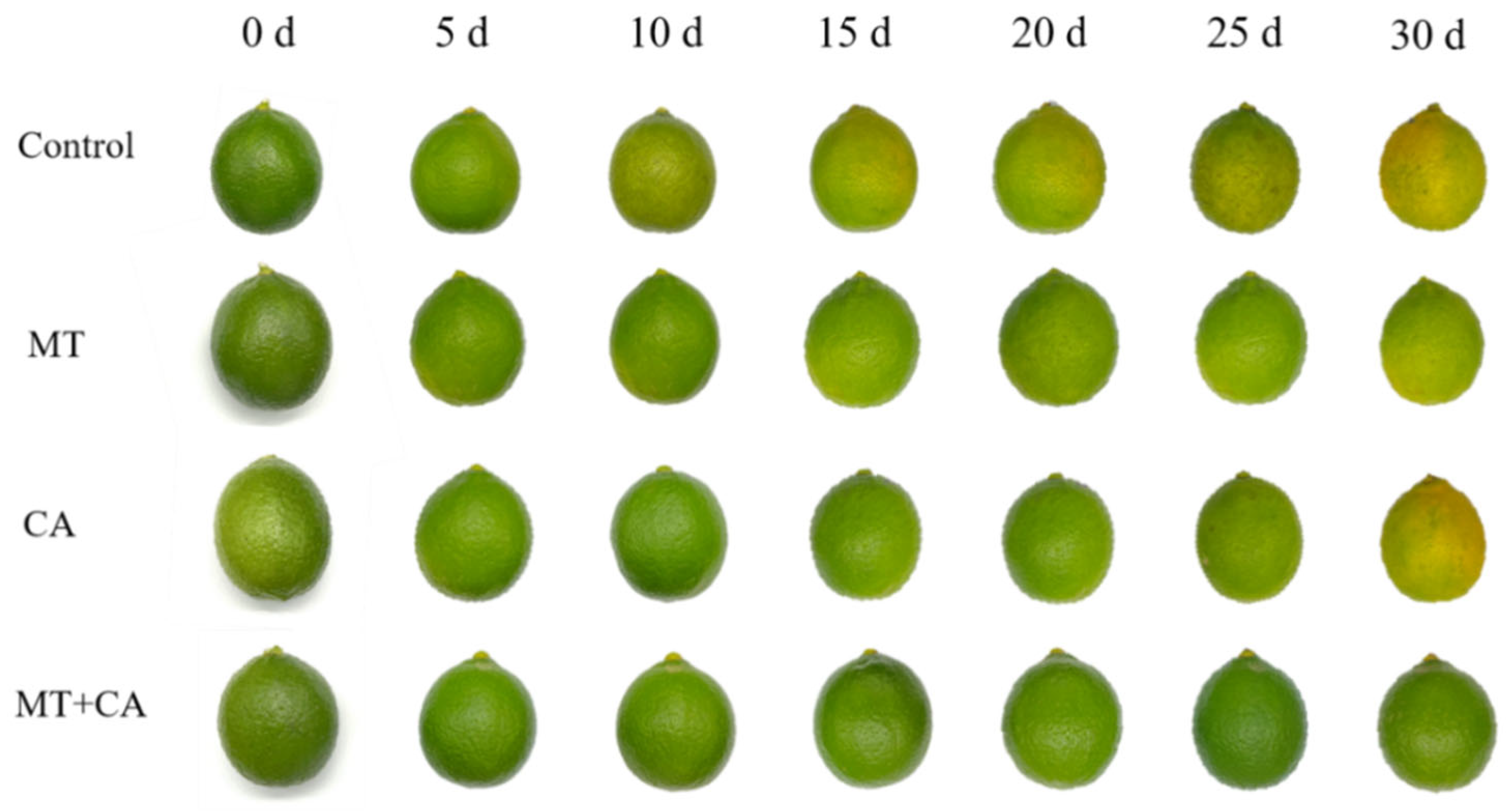
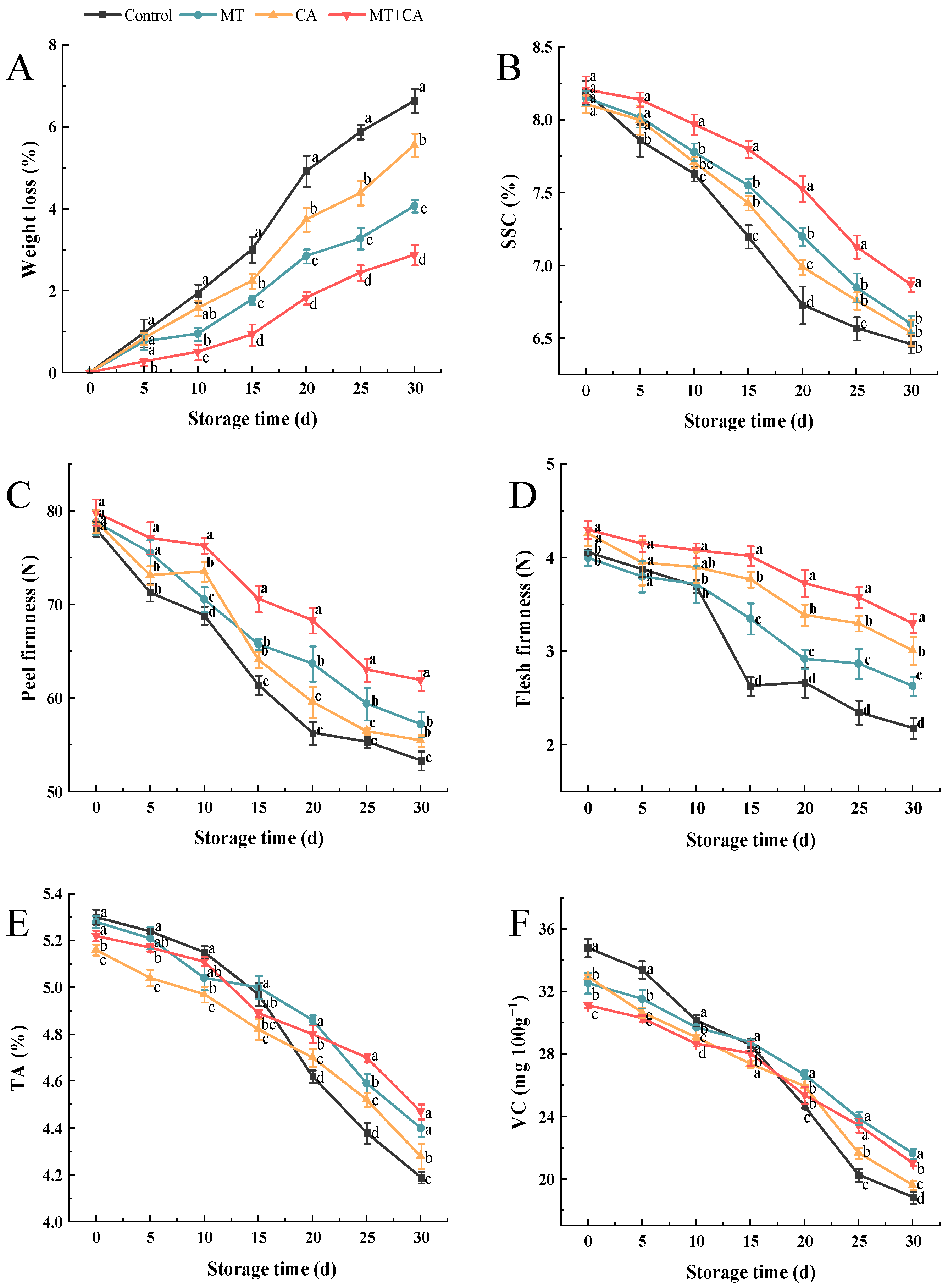
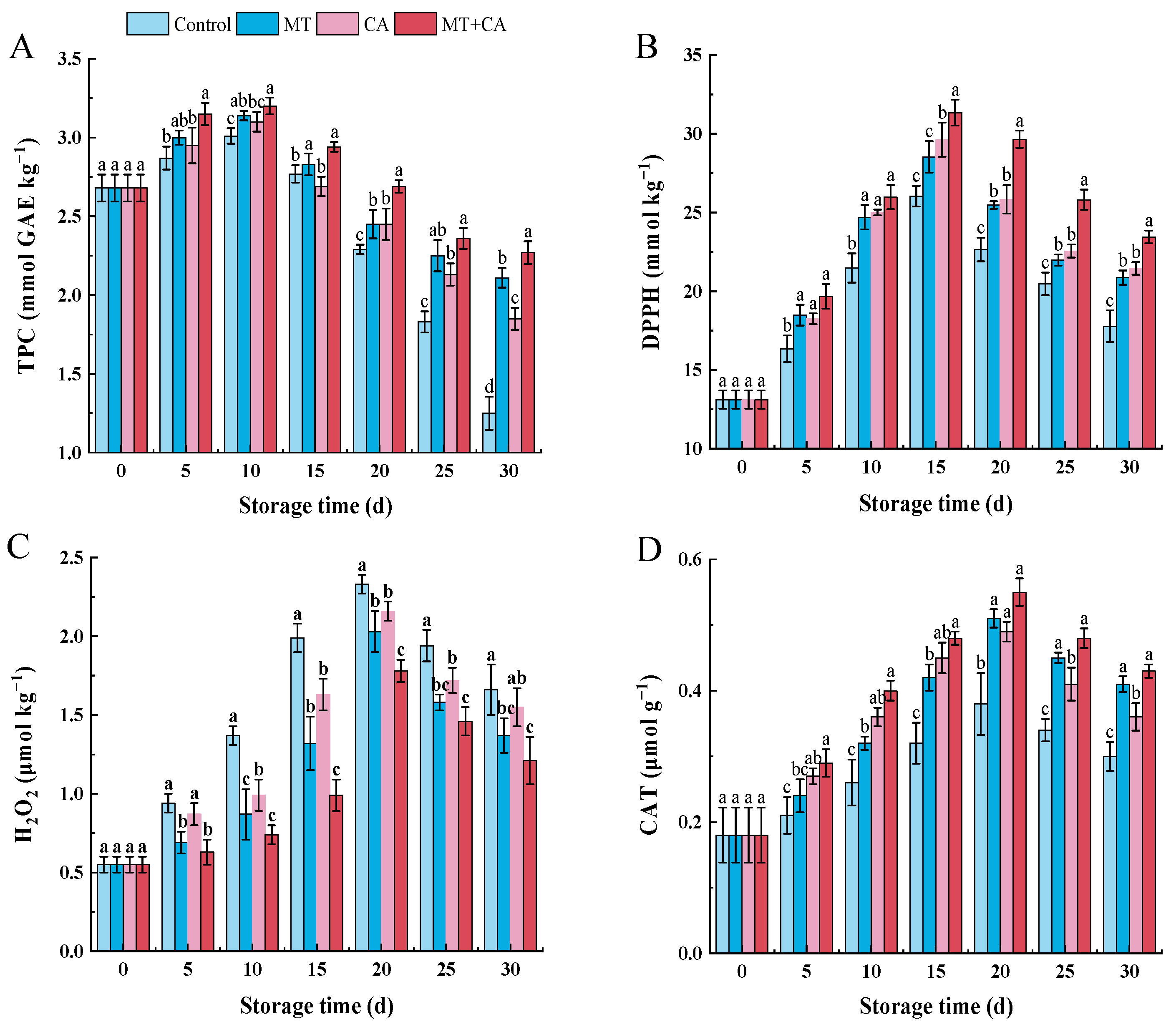
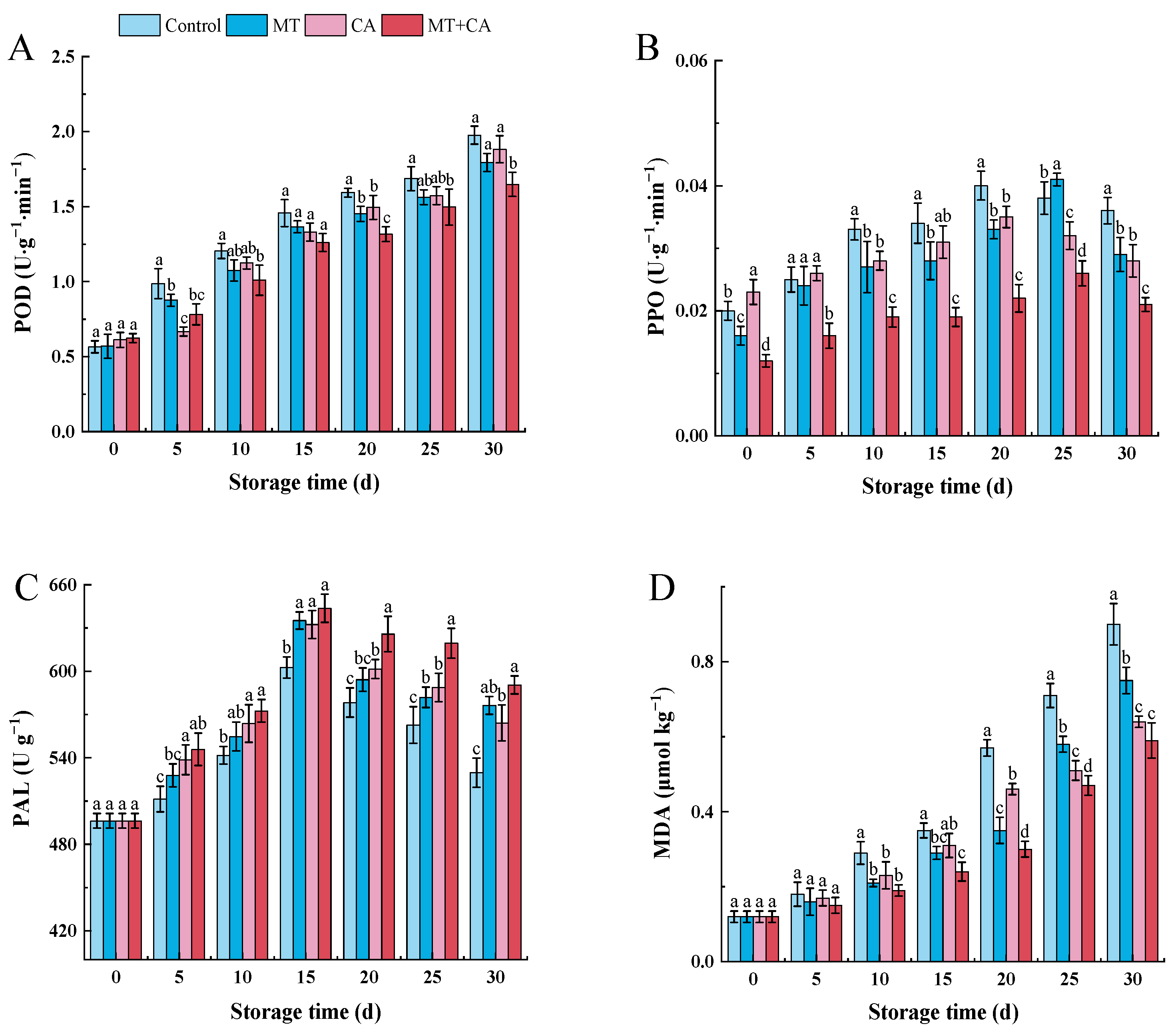
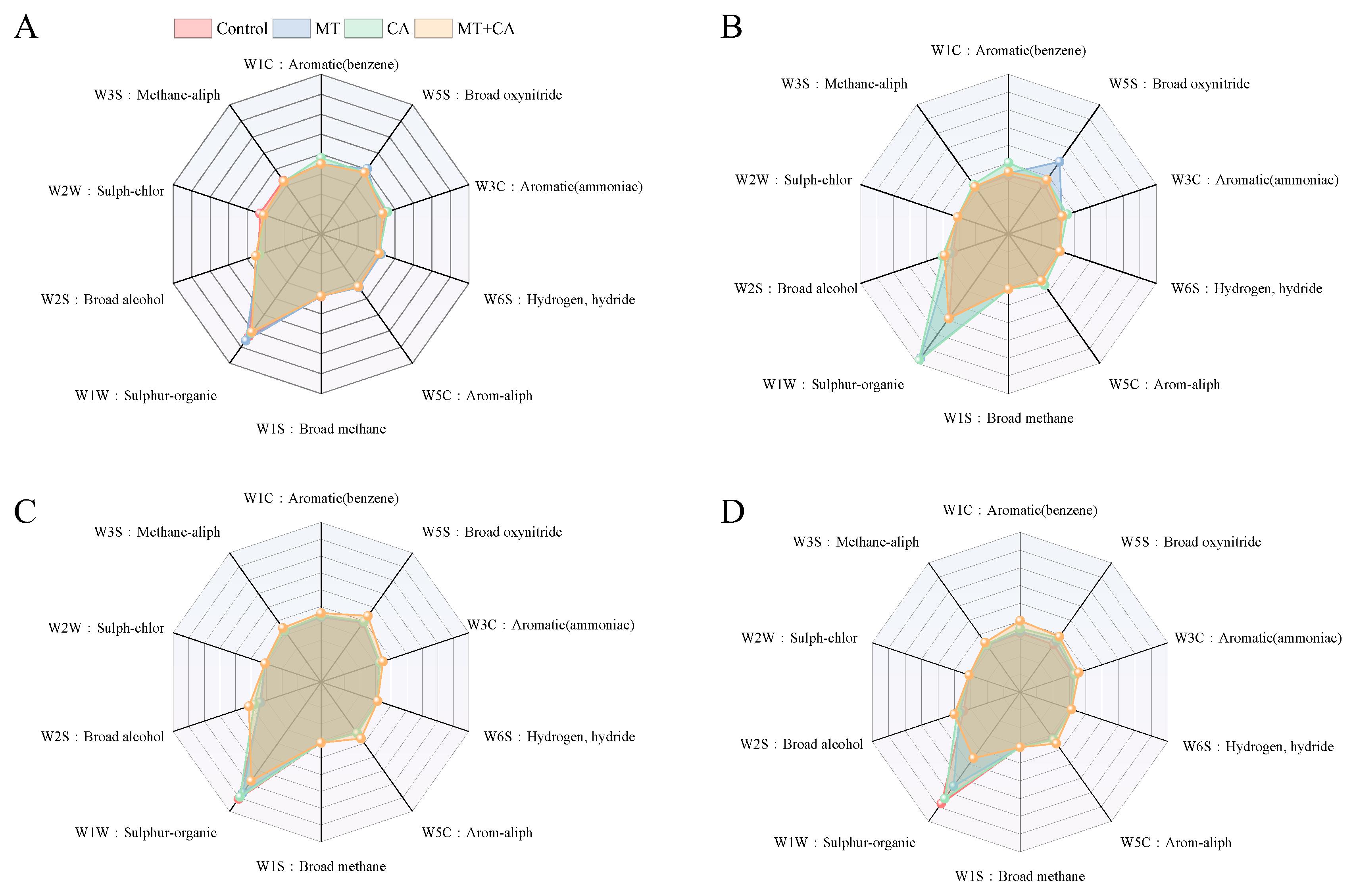
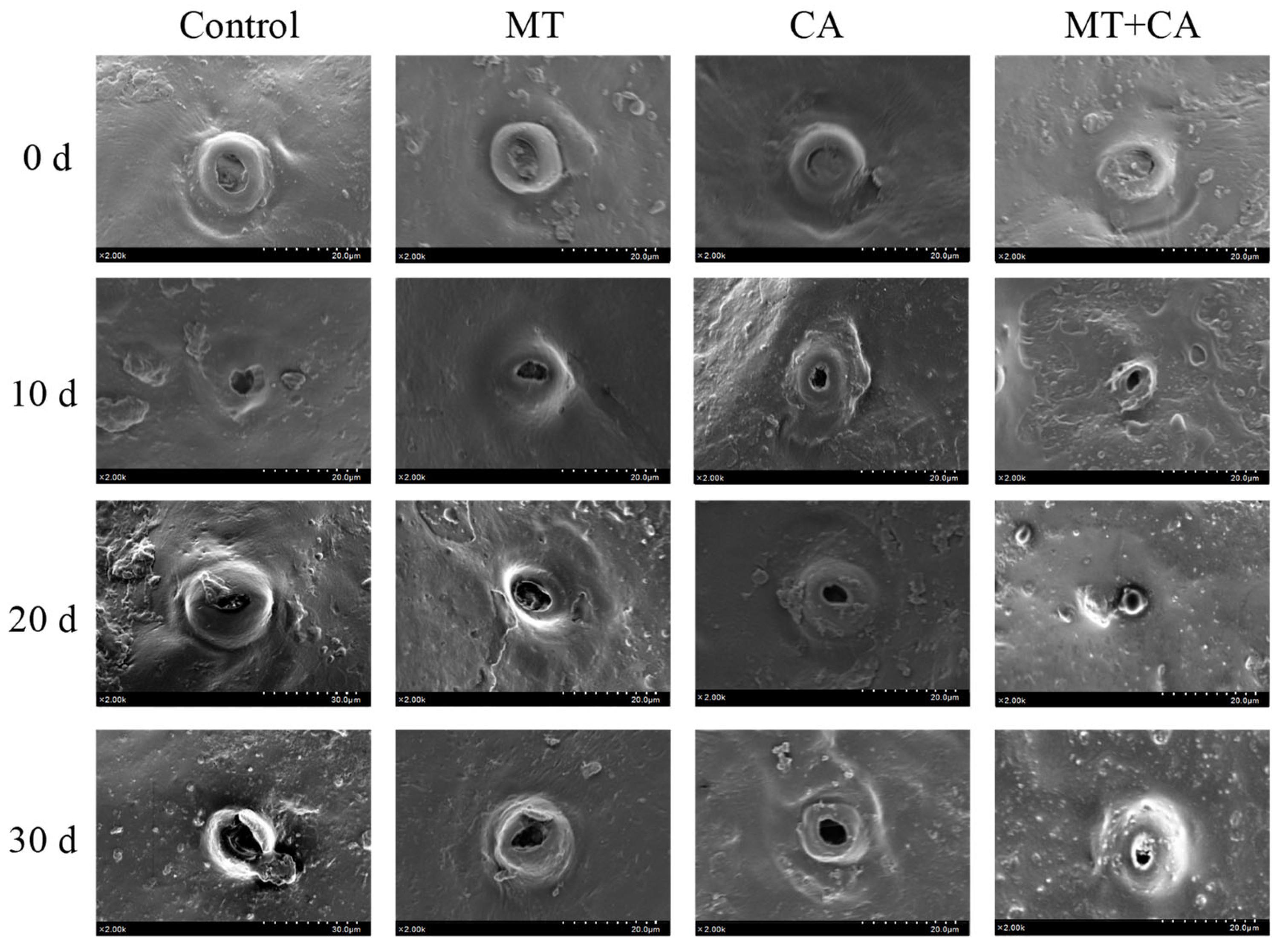
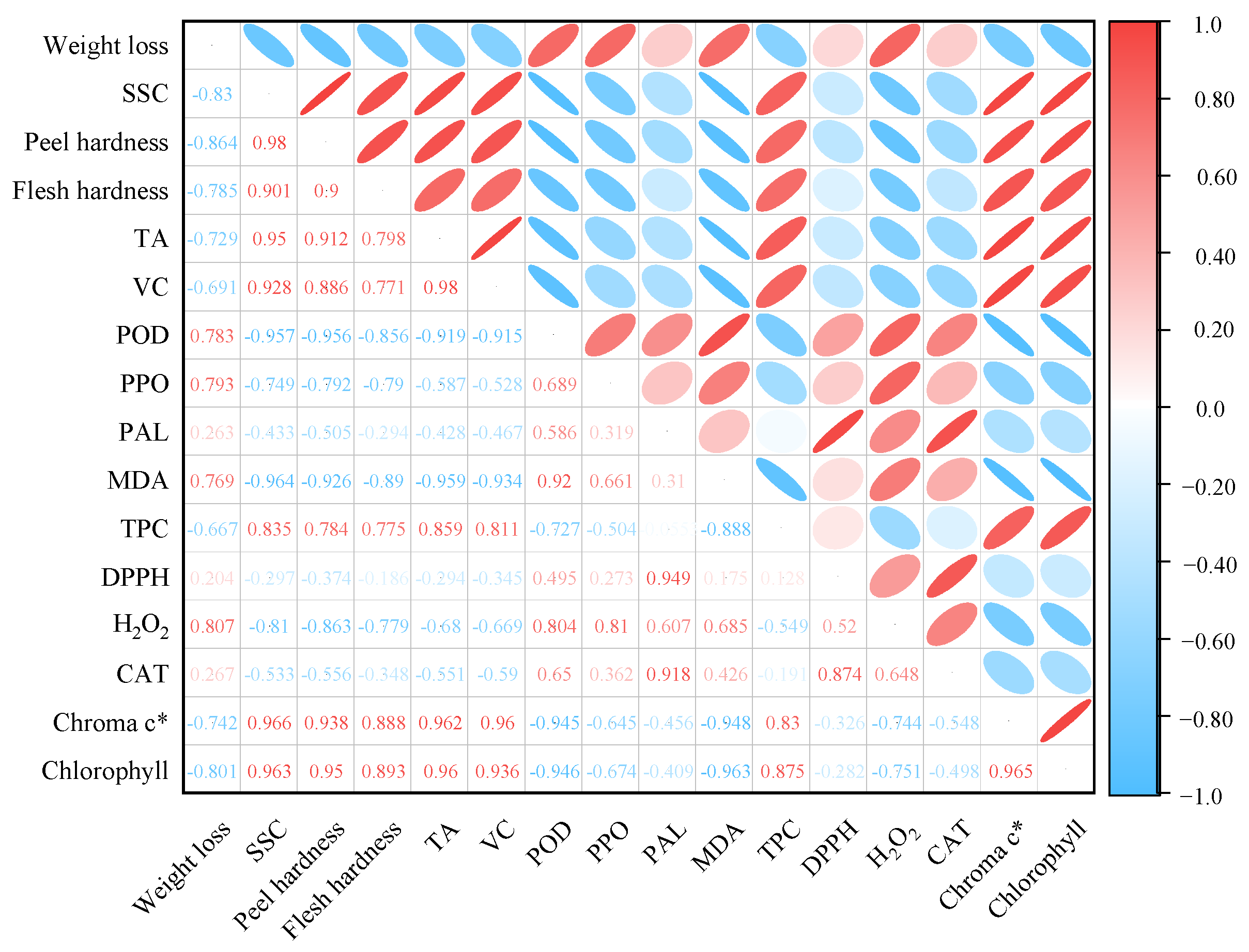
| Time | Treatment | Chroma C* | Chlorophyll (mg/g) |
|---|---|---|---|
| 0 d | Control | 29.6 ± 0.17 a | 44.15 ± 0.72 ab |
| MT | 30.9 ± 0.18 b | 46.33 ± 0.55 ab | |
| CA | 27.8 ± 0.17 b | 45.15 ± 1.73 b | |
| MT+CA | 25.3 ± 0.07 c | 46.58 ± 1.23 a | |
| 10 d | Control | 35.2 ± 0.13 a | 38.35 ± 2.01 b |
| MT | 33.1 ± 0.22 a | 40.62 ± 1.39 ab | |
| CA | 31.0 ± 0.06 ab | 40.19 ± 1.35 ab | |
| MT+CA | 27.9 ± 0.09 b | 42.36 ± 1.25 a | |
| 20 d | Control | 38.4 ± 0.12 a | 26.87 ± 1.61 c |
| MT | 40.7 ± 0.06 ab | 29.64 ± 1.58 b | |
| CA | 34.5 ± 0.09 b | 28.48 ± 1.59 bc | |
| MT+CA | 34.0 ± 0.08 b | 32.22 ± 0.82 a | |
| 30 d | Control | 49.4 ± 0.11 a | 10.37 ± 0.96 d |
| MT | 47.3 ± 0.15 a | 19.62 ± 0.93 b | |
| CA | 36.7 ± 0.27 a | 14.11 ± 1.17 c | |
| MT+CA | 34.6 ± 0.06 a | 28.47 ± 1.13 a |
Disclaimer/Publisher’s Note: The statements, opinions and data contained in all publications are solely those of the individual author(s) and contributor(s) and not of MDPI and/or the editor(s). MDPI and/or the editor(s) disclaim responsibility for any injury to people or property resulting from any ideas, methods, instructions or products referred to in the content. |
© 2024 by the authors. Licensee MDPI, Basel, Switzerland. This article is an open access article distributed under the terms and conditions of the Creative Commons Attribution (CC BY) license (https://creativecommons.org/licenses/by/4.0/).
Share and Cite
Yang, M.; Zheng, E.; Lin, Z.; Miao, Z.; Li, Y.; Hu, S.; Gao, Y.; Jiang, Y.; Pang, L.; Li, X. Melatonin Rinsing Treatment Associated with Storage in a Controlled Atmosphere Improves the Antioxidant Capacity and Overall Quality of Lemons. Foods 2024, 13, 3298. https://doi.org/10.3390/foods13203298
Yang M, Zheng E, Lin Z, Miao Z, Li Y, Hu S, Gao Y, Jiang Y, Pang L, Li X. Melatonin Rinsing Treatment Associated with Storage in a Controlled Atmosphere Improves the Antioxidant Capacity and Overall Quality of Lemons. Foods. 2024; 13(20):3298. https://doi.org/10.3390/foods13203298
Chicago/Turabian StyleYang, Mengjiao, Enlan Zheng, Ziqin Lin, Ze Miao, Yuhang Li, Shiting Hu, Yanan Gao, Yuqian Jiang, Lingling Pang, and Xihong Li. 2024. "Melatonin Rinsing Treatment Associated with Storage in a Controlled Atmosphere Improves the Antioxidant Capacity and Overall Quality of Lemons" Foods 13, no. 20: 3298. https://doi.org/10.3390/foods13203298
APA StyleYang, M., Zheng, E., Lin, Z., Miao, Z., Li, Y., Hu, S., Gao, Y., Jiang, Y., Pang, L., & Li, X. (2024). Melatonin Rinsing Treatment Associated with Storage in a Controlled Atmosphere Improves the Antioxidant Capacity and Overall Quality of Lemons. Foods, 13(20), 3298. https://doi.org/10.3390/foods13203298





